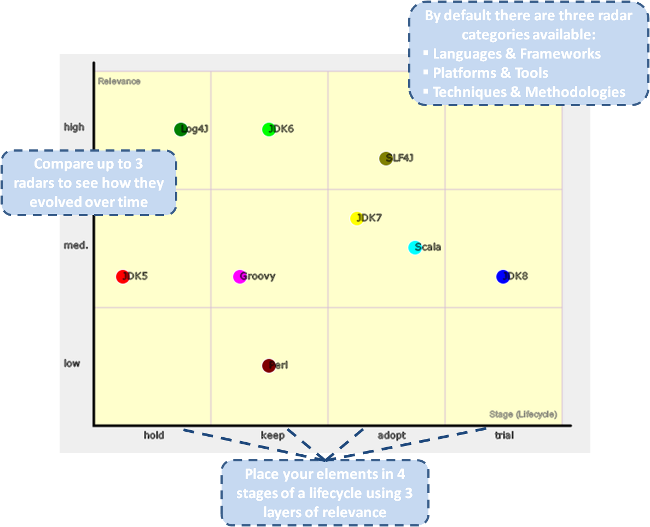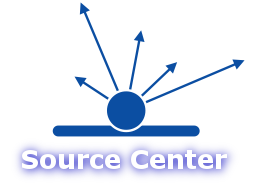| Name | Stage | Relevance | X-Tendency | Y-Tendency | Description |

Category:
Clone another:
Current Radar:
Older Radar to compare:
Oldest Radar to compare:
Welcome to the TecRadar application.
For more details about usage please consult the about page.

TecRadar Guide
This TecRadar was intended to categorize several elements like a certain technology in matters of its lifecycle and its relevance. The main goal was to have a visualized basis for discussions to talk about questions like:
- What's coming up on the horizon? And why is it interesting?
- What is the current pervasiveness of a technology? Or with which potential does it ship?
- What are the things we want to get rid of and why?
- What has been evaluated and assessed as useful?
- Lifecycle (x-axis): defines in which stage the current element is.
- trial: You see it on the horizon.
- adopt: You already experimented with it and assessed it as practical.
- keep: This is in use and can be used without doubts.
- hold: Deprecated, should be avoided or replaced when possible.
- Relevance (y-axis: defines depending on the stage the particula relevance.
- high: Highly relevant.
- medium: Medium relevant.
- low: Low relevant.
Example: Imagine your typical business is somehow related with interpretation of data and you have a big datawarehouse in usage. This lifecycle of this technology is keep and because of its high pervasion its relevance is high. Then you discover a map reduce framework e.g. hadoop. Lifecycle is trial because you just evaluate it. The relevance is high because if you can use it it will maybe revolutionize your whole system landscape by replacing the current one totally.
Categories
In the TecRadar you can place whatever you want. But too many elements or bubbles in the chart lead to a confusing picture. This is why we introduced three categories:
- Languages & Frameworks
- Platforms & Tools
- Techniques & Methodologies
| Category | Explanation | Examples |
| Languages & Frameworks | A language is often the basis a developer needs to develop. This also includes script or markup languages as well as notations. Frameworks typically extend languages for functionalities that are not part of the language itself. |
Java, C#, PHP, Python, Perl, Javascript, Html, BPMN, etc. JEE, Spring, log4j, jQuery, Qooxdoo, Bootstrap, etc. |
| Platforms & Tools | A platform is typically a kind of base infrastructure you build your applications on top and/or install it upon (definition includes container). Tools are often part of the platform as part of the ecosystem and are defined as a helpful things you additionally use to ease or to homegenize something. |
JBoss, Tomcat, Equinox, Hadoop, etc. Maven, Ant, etc. |
| Techniques & Methodologies | A techniques is an approach, a concept or procedure that is applied to software development and influences the structure of implementation or the implementation of software itself. Methodologies are methods or procedure models that are applied to structure the way of implementation (overlaps to techniques are possible). |
TDD, MDA, REST, etc. Waterfall, Scrum, Kanban, etc. |
Note 2: The right level of abstraction depends on you. So you can use it with less important elements or microversions of technologies but also without versions and respecting important elements with a minimum level of pervasion only.
Comparison over time
Sometimes it can be also interesting to look back instead of only looking ahead. If this radar is filled out continuously you can visualize the changes of a radar using up to three saved states.
Licence
You can adapt and install your own TecRadar application if you like. It is available at GitHub under Apache Licence Version 2.0:Copyright 2015 Matthias Wittum
Licensed under the Apache License, Version 2.0 (the "License");
you may not use this file except in compliance with the License.
You may obtain a copy of the License at
http://www.apache.org/licenses/LICENSE-2.0
Unless required by applicable law or agreed to in writing, software
distributed under the License is distributed on an "AS IS" BASIS,
WITHOUT WARRANTIES OR CONDITIONS OF ANY KIND, either express or implied.
See the License for the specific language governing permissions and
limitations under the License.
1&1 Source Center
The idea of this TecRadar was born while talking about frameworks and tools we are using in our company.
Matthias initiated this discussion and the result after a few discussions was the concept for this tool.
As Head of the 1&1 Source Center he is normally in charge of
"Finding the right persons (developers) and placing them into a position that fits best to their skills and themselves."
